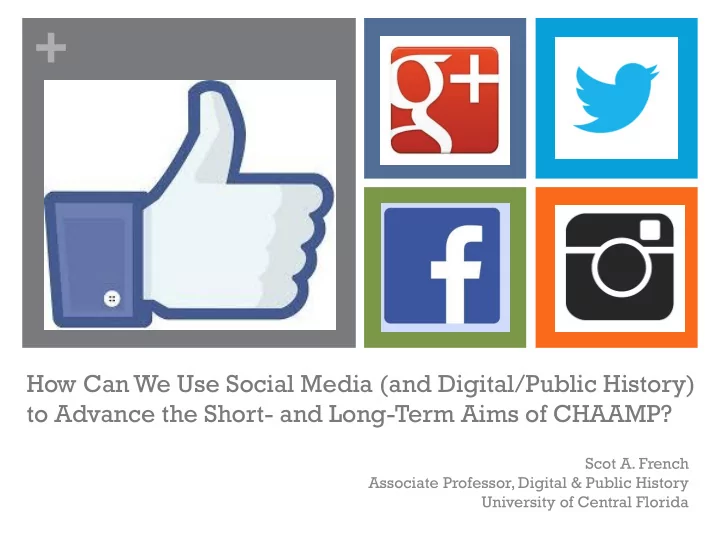

+ How Can We Use Social Media (and Digital/Public History) to Advance the Short- and Long-Term Aims of CHAAMP? Scot A. French Associate Professor, Digital & Public History University of Central Florida
+ My Background 2000: Ph.D. in History, University of Virginia 1994-2006: Assoc. Dir., Carter G. Woodson Institute for African American and African Studies 2007-2009: UVA in Ghana Program Director 2006-2010: Director, Virginia Center for Digital History 2011-Present: Associate Professor of Digital and Public History at the University of Central Florida
+ Cape Coast ‘ Zongo ’ District – Heritage Conservation & Oral History Project (2009)
+ What is Digital History? Here’s a good working definition from historians Douglas Seefeldt and William G. Thomas at the University of Nebraska @ Lincoln: Digital history might be understood broadly as an approach to examining and representing the past that works with the new communication technologies of the computer, the internet network, and software systems. Digital history invites readers to investigate and form interpretive associations of their own. This might be the defining characteristic of this genre. Readers are not presented with an exhibit, or an article with many appendices, or any other analog form simply reprocessed into a web-deliverable format. Instead, they are presented with a suite of interpretive elements, ways to gain leverage on the problem under investigation .”
+ CHAAMP focuses on the History of African Americans in the Medical Professions Q: What does the “C” Stand For?
+
+ Today I’d like to talk about using Social Media and Digital/Public History to … Brand and Promote the CHAAMP Conference Identify and Build the CHAAMP Community Enhance and Expand the CHAAMP Collection Enable Collaboration Within and Across the CHAAMP Consortium
+ 1. Using Social Media to Brand & Promote the CHAAMP Conference Freelance web designer Lindsey Leemis designed a dynamic, visually attractive website with essential conference program info: speakers, agenda, hotel info, etc. The website incorporated visual elements (logo, font, color palette) carefully chosen by Dr. P. Preston Reynolds, J.D. Talasek, & other design consultants.
+ CHAAMPconference.com ... Not to be confused with CHAAMP.org Chesapeake Area Alaskan Malamute Protection
+ 2. Using Social Media to Identify and Build the CHAAMP Community Christine Madrid French, an historian, blogger, and social media specialist, created a Facebook account (CHAAMP: History of African Americans in the Medical Professions) to promote the conference and initiate a long-term network-building process.
+ Chris also created a Twitter account (@CHAAMP2013), imported contact info for conferees, and “followed” a number of groups (including @CPNAS and other CHAAMP conference sponsors) with either a general or specialized interest in the history of African Americans in the health professions.
+ Using Social Media to Identify & Build the CHAAMP Community Finally, using email addresses gleaned from conference registration and a free, third-party email marketing program, Chris created a CHAAMP- branded “newsletter” to communicate with conferees before, during, and after the event. CHAAMP Conferees (you!!!) are urged to Friend on Facebook, Follow on Twitter, or Forward to a Friend.
+ CHAAMP “C” is for Collection
+ 3. How Can We Use Social Media and to Enhance & Expand the CHAAMP Collection?
+ Collecting ‘The People’s History’ via Facebook Open Group Sites I grew up in Sanford, Florida, and am not ashamed to admit it An Open Group 2,450 members “A place we can share memories of growing up in Sanford”
+
+
+ Collecting ‘The People’s History’ through Community-Based History Harvests
+ Engaging Students in Local Research: Medical History as Community History Dynamic timeline visualization based on research by Kendra Grinnage (U.Va. undergrad) and Nena Patterson (U.Va.grad)
+ Local Legend: Dr. J.A. Jackson of Charlottesville, Virginia, 1888-1956 1888-1906: Born in Petersburg, Va.; • graduates from Peabody High School • 1913: Graduates from Howard University, Doctor of Dentistry 1914: Purchases home in Charlottesville’s • Vinegar Hill/Starr Hill neighborhood (Commerce/4 th St. NW) • 1922: Establishes Crescent Drug Co. at 283 W . Main St.; business later moved to his Commerce Street property • 1924: National Dental Association founded; Jackson first Sec/Treasurer 1937: Opens NDA headquarters on his • Commerce St. property 1950: President of John A. Andrew Hospital • Clinical Society at Tuskegee
+ Vinegar Hill: A MemoryScape Virtual/Walking Tours Left: Dr. Jackson’s former home/office on Commerce St. today Right: A visualization of the Vinegar Hill residential neighborhood and business district, ca. 1965, based on historical data, images, oral histories VinegarHillProject.org
+ 5. Using Social Media to Enable Collaboration Within and Across the CHAAMP Consortium
+ Tapping into CHAAMP Sponsor Twitter Feeds/Social Networks
+ Using Google Hangouts for Virtual Brainstorming / Breakout Groups Up to 9 • participants in video chat; others may view/tweet by invitation Conversation • can be recorded and archived on YouTube (CHAAMP Channel)
+ Help us build an active CHAAMP community of users! Ideas? Share them with us! Let’s chat during the workshop and stay connected via Facebook, Twitter, and other social media
Recommend
More recommend